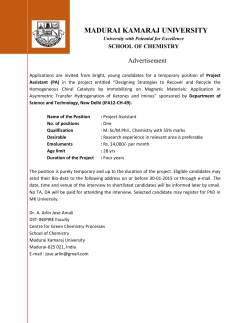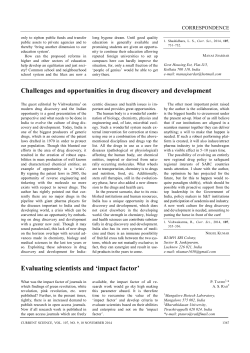
CHEM101-Syllabus - Chemistry at DOGUS
Teaching Plan DOĞUŞ UNIVERSITY Week 1 Chapter 1. Introduction: Matter and Measurement CHEM 101 - CHEMISTRY Definition of chemistry, scientific method, units and measurements, uncertainty in measurements, accuracy and precision, significant figures, mathematical calculation with significant figures, conversion factors, dimensional analysis, temperature and temperature scales, density as an identification tag, matter and its classification Spring Term, 2014-2015 Week 2 Chapter 2. Atoms, Molecules and Ions Instructor and Course Coordinator: Asst. Prof. Dr. Ayşen Tulpar Room: B4-703/C , Tel: 1535, E-mail: atulpar@dogus.edu.tr Office Hours: Tuesday 10:00-11:00, Wednesday 10:00-11:00 Fundamental chemical laws: Law of conservation of mass, law of definite proportions, law of multiple proportions, atomic theories and related experiments, Dalton’s atomic theory, modern view of atomic structure, molecular and ionic compounds, chemical bonds, introduction to periodic table, metals, non-metals and metalloids, naming simple compounds: Binary ionic compounds types I and II, ionic compounds with polyatomic ions, binary covalent compounds (type III), acids Course Assistant: Zeynep Eslek, MS in Chemical Engineering, Room: B4-815, zeslek@dogus.edu.tr Office Hours: Monday 15:00-16:00, Tuesday 11:00-12:00, Thursday 11:00-12:00 Week 3 and 4 Chapter 3. Stoichiometry: Quantitative Chemical Relationships Atomic masses, mole concept, molar mass, percent composition of compounds, determining the formula of a compound, empirical formula, molecular formula, chemical equations, chemical reactions, the meaning of a chemical equation, balancing chemical equations, stoichiometric calculations: amounts of reactants and products, limiting and excess reactants, calculations involving limiting reactants, yield and related calculations Course Website: http://chemistry.dogus.edu.tr/teaching.htm Purpose To give the freshmen engineering students a background on the structure of matter, stoichiometry, chemical reactions in solutions, properties of gases and solutions, thermodynamics, kinetics and reaction rates, and chemical equilibria. To show the students how nature behaves around us, and how scientific method is applied to understand nature. Most importantly, this course aims to teach the students how to approach problems in a step-by-step fashion, which can be applied to any type of problem in chemistry or in any other field of science and/or engineering. Nature of energy, conservation of energy, chemical, kinetic, and potential energies, enthalpy, calorimeter, Hess’ law, heat of reaction, standard heat of formation, present sources of energy, new energy sources. Main Text Chemistry: The Central Science, T.L. Brown, H.E. Lemay, B.E.Bursten, and C.J. Murphy, 12th Ed., Prentice-Hall, 2012 Additional Readings 1) Chemistry, Steven S. Zumdahl and Susan A. Zumdahl, 5th Ed., 2000, Houghton Mifflin Co. 2) Chemistry: The Study of Matter and Its Changes, Brady and Holum, 3rd Ed. 2000, Wiley 3) General Chemistry: Principles and Modern Applications, R.H. Petrucci,W.S. Harwood, 9th Ed. 2008, Prentice Hall Attendance Minimum 70% attendance to the lectures is a must. This corresponds to 39 lecture hours. Week 9 and 10 Chapter 10. Gases Gas laws of Boyle, Charles, Guy-Lussac, Avogadro’s principle, ideal gas and combined gas laws, gas stoichiometry, Dalton’s law of partial pressures, kinetic molecular theory of gases, meaning of temperature, root mean square velocity, effusion and diffusion, real gases. Week 11 Chapter 13. Physical Properties of Solutions Solution composition, energies of solution formation, solubility and factors affecting solubility, temperature, pressure and structure effects on solubility, vapor pressure of solutions, ideal and non-ideal solutions, boiling point elevation (increase) and freezing point depression (decrease), osmosis and osmotic pressure, reverse osmosis, colligative properties of electrolyte solutions, colloids Week 12 and 13 Chapter 14. Chemical Kinetics Reaction rates and rate laws, order of reactions, determining the form of the rate law, differential and integrated rate equations, reaction mechanism, model for chemical kinetics, catalyst and catalysis (homogenous and heterogeneous) Grading Saturday, April 4th, 2015 @ 10:30 Definition of solution, solvent, solute, H2O as a common solvent, nature of aqueous solutions, strong and weak electrolytes, non-electrolytes, composition of solutions, dilute, concentrated and saturated solutions, molarity, precipitation reactions, acid-base reactions, nature of acids and bases, acid strength, pH-scale, calculating pH of strong acids, oxidation-reduction (redox) reactions, oxidation states, rules on solubility, balancing redox reactions, oxidizing and reducing agents, titrations in aqueous solutions Week 7 , 8 and 9 Chapter 5. Thermochemistry Method a) Interactive lecturing b) Concepts supported by example problems c) Certain experiments carried out in chemistry lab Exam Laboratory + Quiz + HMWK + Class Participation Final Week 5 and 6 Chapter 4. Types of Chemical Reaction and Solution Stoichiometry 30 % 25 % 45 % Week 13 and 14 Chapter 15. Chemical Equilibrium The equilibrium condition, characteristics of chemical equilibrium, equilibrium constant, equilibrium involving pressures, heterogeneous equilibria, extent of reaction, calculation of equilibrium pressures and concentrations, Le Chatelier principle. Problem Solving Sessions and Suggested Problems The students are expected to work on the problems at the end of each chapter of the main text: Chemistry: The Central Science. The table below gives a list of suggested problems. There will be problem solving sessions one week after the finish of each chapter, giving mainly the answers to the suggested problems and any questions the students may have. The dates and times of problem sessions will be announced throughout the semester. Chapter 1 Suggested Problems 1-38, 1-39, 1-40, 1-46, 1-73 Chapter 2 2-49, 2-57, 2-67, 2-71, 2-90, 2-92 Chapter 3 3-12, 3-37, 3-43, 3-53, 3-61, 3-65, 3-76, 3-83, 3-107a Chapter 4 4-24, 4-39, 4-51, 4-58, 4-76, 4-82, 4-87, 4-89, 4-104 Chapter 5 5-38, 5-43, 5-60ab, 5-75, 5-79, 5-101a, 5-104a Chapter 10 10-17, 10-43, 10-50, 10-62, 10-71, 10-117, 10-125 Chapter 13 13-34, 13-41, 13-56, 13-65a, 13-73, 13-93, 13-102, 13-104 Chapter 14 14-23abc, 14-37, 14-99, 14-106, 14-119 Chapter 15 15-39abc, 15-33, 15-46, 15-55, 15-62, 15-88, 15-97
© Copyright 2025



















